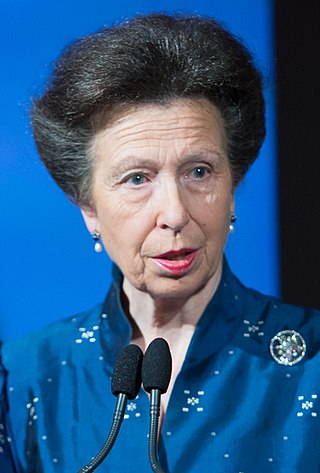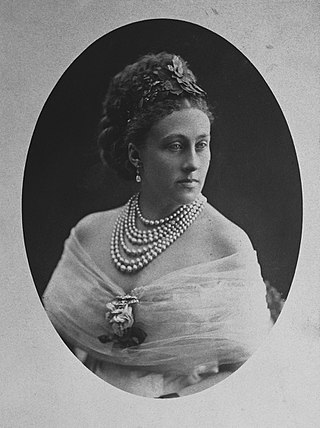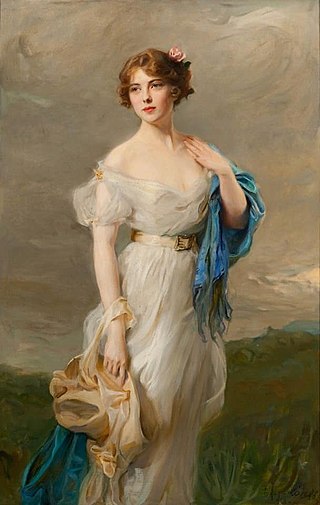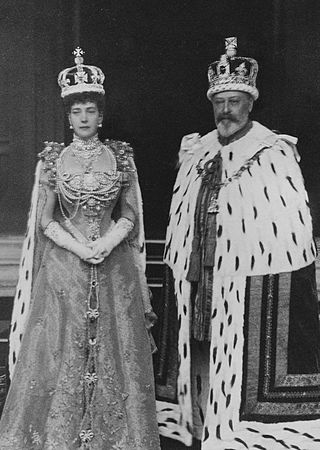
Philip Alexius László de Lombos, known professionally as Philip de László, was an Anglo-Hungarian painter known particularly for his portraits of royal and aristocratic personages. In 1900, he married the Anglo-Irish socialite Lucy Guinness, and he became a British subject in 1914. László's patrons awarded him numerous honours and medals. He was invested with the Royal Victorian Order by Edward VII in 1909 and, in 1912, he was ennobled by Franz Joseph I of Austria; becoming a part of the Hungarian nobility.

The Mountbatten family is a British dynasty that originated as an English branch of the German princely Battenberg family. The name was adopted on 14 July 1917, three days before the British royal family changed its name from "Saxe-Coburg and Gotha" to "Windsor", by members of the Battenberg family residing in the United Kingdom, due to rising anti-German sentiment among the British public during World War I. The name is a direct Anglicisation of the German Battenberg, or Batten mountain, a small town in Hesse. The titles of count and later prince of Battenberg had been granted in the mid-19th century to a morganatic branch of the House of Hesse-Darmstadt, itself a cadet branch of the House of Hesse.

The use of the title of Princess of the United Kingdom of Great Britain and Northern Ireland is entirely at the will of the sovereign as expressed in letters patent. Individuals holding the title of princess are styled "Her Royal Highness" (HRH). On 18 April 1917, Frederica of Hanover, the newest granddaughter of Wilhelm II, German Emperor was styled a British princess from birth, even though Germany and Britain were fighting in World War I. Before the First World War, British princesses also held additional German titles, such as princesses of Hanover by virtue of being male-line descendants of George III; or princesses of Saxe-Coburg and Gotha, duchess of Saxony, by virtue of being male-line descendants of Prince Albert of Saxe-Coburg and Gotha. George V issued letters patent on 30 November 1917, to restrict the automatic assignment of the title "princess" and the use of the style "Royal Highness" to the following persons:

Louisa Frederica Augusta Cavendish, Duchess of Devonshire, formerly Louisa Montagu, Duchess of Manchester, was a German-born British aristocrat sometimes referred to as the "Double Duchess" due to her marriages, firstly to the 7th Duke of Manchester and then to the 8th Duke of Devonshire.

Lieutenant David Michael Mountbatten, 3rd Marquess of Milford Haven,, styled Viscount Alderney before 1921 and Earl of Medina between 1921 and 1938, was the son of the George Mountbatten, 2nd Marquess of Milford Haven and Countess Nadejda Mikhailovna of Torby.

Captain George Louis Victor Henry Serge Mountbatten, 2nd Marquess of Milford Haven,, born Prince George of Battenberg, styled Earl of Medina between 1917 and 1921, was a Royal Navy officer and the elder son of Louis Mountbatten, 1st Marquess of Milford Haven, and Princess Victoria of Hesse and by Rhine.
Natalia Ayesha Grosvenor, Duchess of Westminster, is a British aristocrat, philanthropist and winemaker. She is the widow of the 6th Duke of Westminster and mother of the 7th Duke. As of 2021, the Duchess's family, specifically her son, were 12th on the Sunday Times Rich List with a net worth of £10.045 billion.

Alexandra Anastasia Hamilton, Duchess of Abercorn, was a British peeress and philanthropist. She was the wife of James Hamilton, 5th Duke of Abercorn, and a descendant of Russian poet Alexander Pushkin, in whose honour she founded the Pushkin Trust and the Pushkin prizes.

Grand Duke Michael Mikhailovich of Russia was a son of Grand Duke Michael Nicolaievich of Russia and a grandson of Tsar Nicholas I of Russia.

Lady Anastasia Mikhailovna Wernher was a German-born Russian-British aristocrat and thoroughbred racehorse owner.

Lady Elizabeth Mary Finch-Hatton was a British aristocrat and the subject of a notable painting, once thought to be by Johann Zoffany, now attributed to David Martin.

Countess Sophie Nikolaievna of Merenberg, Countess de Torby, was the elder daughter of Prince Nikolaus Wilhelm of Nassau and his morganatic wife, Natalia Alexandrovna Pushkina.

Sybil Mary Fane, Countess of Westmorland, born Lady Sybil Mary St Clair-Erskine, was a British aristocrat and socialite.

On 6 July 1893, Prince George, Duke of York, and Princess Victoria Mary of Teck were married at the Chapel Royal, St. James's Palace, in London, England.

The coronation of Edward VII and his wife, Alexandra, as king and queen of the United Kingdom and the British Dominions, and as emperor and empress of India took place at Westminster Abbey, London, on 9 August 1902. Originally scheduled for 26 June of that year, the ceremony had been postponed at very short notice, because the King had been taken ill with an abdominal abscess that required immediate surgery. In contrast to the coronation of Queen Victoria, Edward's predecessor, some 64 years earlier, Edward and Alexandra's coronation had been carefully planned as a spectacle reflecting the influence and culture of the British Empire, then at the height of its power, but also as a meaningful religious occasion.

The coronation of George V and his wife, Mary, as king and queen of the United Kingdom and the British Dominions, and as emperor and empress of India, took place at Westminster Abbey, London, on Thursday 22 June 1911. This was the second of four such events held during the 20th century and the last to be attended by royal representatives of the great continental European empires.
The Devonshire House Ball or the Devonshire House Fancy Dress Ball was an elaborate fancy dress ball, hosted by the Duke and Duchess of Devonshire, held on 2 July 1897 at Devonshire House in Piccadilly to celebrate the Diamond Jubilee of Queen Victoria. Due to the many prominent royals, aristocrats, and society figures who attended as well as the overall lavishness of the ball, it was considered the event of the 1897 London Season.

The wedding of Princess Alexandra of Kent and The Honourable Angus Ogilvy took place on Wednesday, 24 April 1963 at Westminster Abbey. Princess Alexandra was the only daughter and second child of Prince George, Duke of Kent, and Princess Marina of Greece and Denmark, while Ogilvy was the second son and fifth child of the 12th Earl of Airlie and Lady Alexandra Coke.

The wedding of Princess Margaret and Antony Armstrong-Jones took place on Friday, 6 May 1960 at Westminster Abbey in London. Princess Margaret was the younger sister of Queen Elizabeth II, while Antony Armstrong-Jones was a noted society photographer.
Harold Pedro Joseph "Bunnie" Phillips, was a British Army officer, holding the rank of lieutenant colonel in the Coldstream Guards.





















